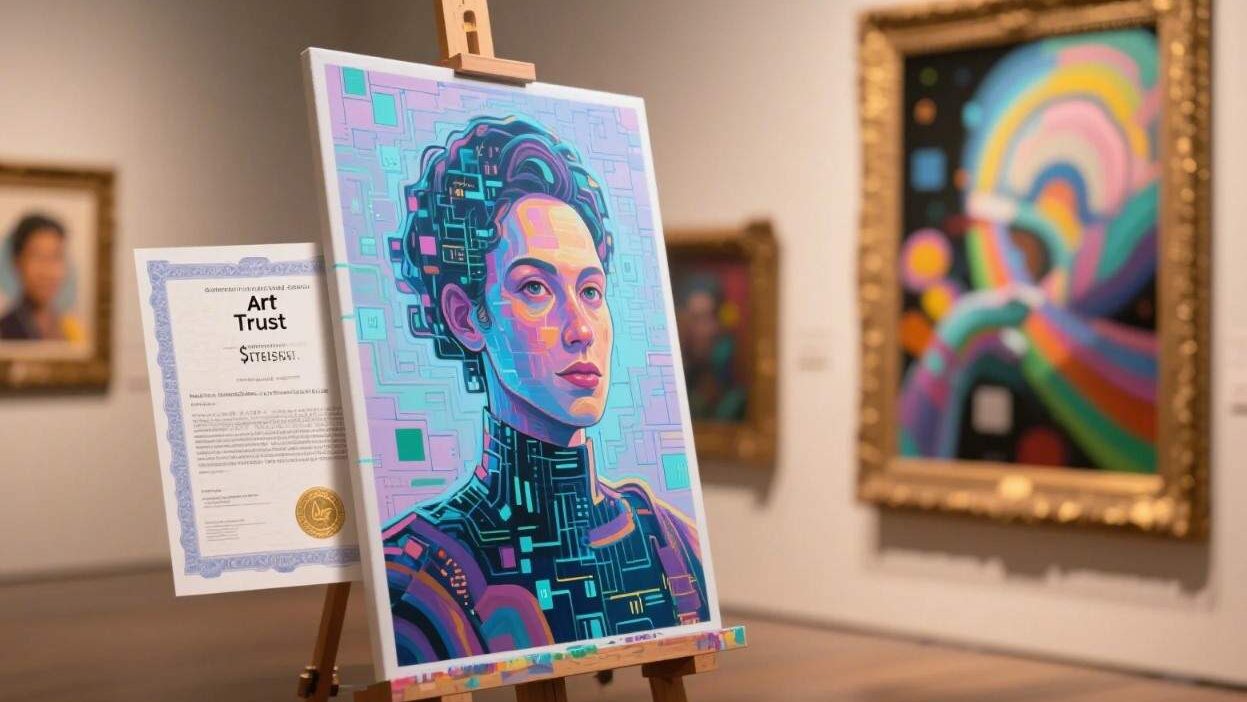Redefining Trust in the Digital Canvas
The Art of Trust in the Digital Age
Digital art—encompassing NFTs, digital paintings, 3D animations, and generative works—has exploded into a $40+ billion market, attracting artists, collectors, and investors alike. Yet, this booming space faces a critical challenge: authenticity. How do buyers verify that a digital artwork is original, unaltered, and owned by the claimed creator? Traditional methods—like physical certificates or expert appraisals—are prone to forgery, fraud, or human error. Enter blockchain technology: a decentralized, immutable ledger that is revolutionizing how we authenticate, own, and trade digital art. This report explores how blockchain is solving the authenticity crisis, empowering creators and collectors with unprecedented transparency and trust.
The Problem: Why Authenticity Matters in Digital Art
Digital art’s intangible nature makes it uniquely vulnerable to fraud:
- Counterfeiting: Fake copies of digital works (e.g., NFTs) can be duplicated infinitely, diluting the value of the original.
- Plagiarism: Artists often face “inspiration” claims or outright theft of their work, with no clear way to prove ownership.
- Provenance Gaps: Without a trusted record of an artwork’s origin, buyers can’t verify if it’s been altered, resold illegally, or stolen.
For example, in 2021, a forged Beeple NFT sold for $69 million before being exposed as a scam. Such incidents erode trust, limiting the market’s growth. Blockchain addresses these issues by creating an unalterable, public record of an artwork’s lifecycle.
How Blockchain Ensures Authenticity: The Tech Behind the Trust
Blockchain’s core features—decentralization, immutability, and cryptographic hashing—make it ideal for verifying digital art. Here’s how it works:
1. Hashing: Creating a Unique “Digital Fingerprint”
Every digital artwork (or NFT) is assigned a unique cryptographic hash—a string of characters generated by an algorithm (e.g., SHA-256). This hash acts as a “digital fingerprint”: even a tiny change to the artwork (e.g., editing a pixel) alters the hash entirely. By storing this hash on the blockchain, anyone can verify that the artwork is unaltered by comparing its current hash to the one on the ledger.
2. Timestamping: Proving Creation and Ownership
Blockchain timestamps every transaction, creating an immutable timeline of an artwork’s history. When an artist mints an NFT, the blockchain records:
- The artist’s wallet address (proving ownership at creation).
- The timestamp of minting.
- Metadata (e.g., title, description, medium).
This timeline ensures that no one can retroactively claim ownership of an artwork created earlier.
3. Smart Contracts: Automating Ownership and Royalties
Smart contracts—self-executing code on the blockchain—automate key functions:
- Ownership Transfers: When an NFT is sold, the smart contract transfers ownership to the buyer’s wallet, with no middleman.
- Royalty Payments: Artists can program smart contracts to automatically receive a percentage (e.g., 10%) of resale proceeds, ensuring ongoing compensation for their work.
For example, digital artist Pak uses smart contracts to ensure his NFTs automatically split royalties between himself and contributing collaborators.
4. Decentralized Verification: No Single Point of Failure
Unlike traditional databases controlled by galleries or auction houses, blockchain operates on a network of nodes (computers). This decentralization means no single entity can alter or censor the ledger, making it resistant to fraud or manipulation.
Benefits: Trust, Transparency, and New Opportunities
Blockchain-verified digital art is transforming the market for creators, collectors, and the industry at large:
1. Empowering Artists: Fair Compensation and Control
- Ownership Proof: Artists can prove they created an artwork, reducing disputes over plagiarism or theft.
- Royalty Automation: Smart contracts ensure artists earn money every time their work is resold, even years after creation. For example, Beeple’s Everydays: The First 5000 Days (sold for $69 million in 2021) includes a 10% royalty clause, meaning Beeple earns a cut of all future sales.
2. Protecting Collectors: Confidence in Authenticity
- Transparent Provenance: Buyers can trace an artwork’s history (e.g., “minted by Artist X on Date Y, resold to Collector Z on Date Z”) via the blockchain, eliminating guesswork.
- Counterfeit Detection: Since each NFT has a unique hash, fake copies are immediately flagged as invalid.
3. Growing the Market: Liquidity and Accessibility
- Mainstream Adoption: Blockchain’s trust factor encourages traditional investors to enter the digital art market. For example, Christie’s and Sotheby’s now regularly auction NFTs, attracting high-profile buyers.
- Democratization: Platforms like OpenSea and Rarible let anyone mint or buy NFTs, lowering barriers to entry for emerging artists.
Challenges: Navigating the Blockchain Frontier
While transformative, blockchain-verified digital art faces hurdles:
1. Technical Complexity
Minting NFTs or understanding blockchain jargon (e.g., “gas fees,” “wallets”) can deter new artists and collectors. Simplifying tools (e.g., user-friendly minting platforms) is critical to broader adoption.
2. Regulatory Uncertainty
Laws around digital assets and NFTs vary globally. For example, the IRS treats NFTs as property, but many countries lack clear regulations on royalties or taxation, creating legal risks.
3. Environmental Concerns
Early blockchains (e.g., Ethereum) relied on energy-intensive “proof-of-work” consensus, raising sustainability concerns. However, shifts to “proof-of-stake” (e.g., Ethereum 2.0) and greener networks (e.g., Tezos) are mitigating this issue.
4. Fraudulent Projects
Scammers exploit blockchain’s novelty with “rug pulls” (fake projects that disappear with investors’ money) or counterfeit NFTs. Due diligence—checking an artist’s reputation, verifying metadata, and using trusted platforms—is essential.
The Future: Blockchain as the New Standard for Digital Art
Innovators are already addressing these challenges, paving the way for a more trusted and inclusive digital art ecosystem:
- Interoperable Standards: Projects like EIP-721 (NFT standards) and ERC-1155 (multi-token standards) ensure NFTs work across platforms, boosting liquidity.
- Ethical AI Integration: Tools like AI-Generated Art Verification use AI to flag potential plagiarism, complementing blockchain’s trust.
- Education Initiatives: Programs like Blockchain for Artists teach creators to navigate minting, royalties, and smart contracts, lowering entry barriers.
A New Era of Trusted Digital Art
Blockchain is not just a buzzword—it’s a revolution in how we value and trade digital art. By providing immutable proof of authenticity, automating royalties, and fostering transparency, blockchain empowers artists to focus on creation and collectors to invest with confidence. As technology evolves and regulations catch up, blockchain-verified digital art will transition from a niche trend to the global standard, redefining the future of creativity and ownership.
The canvas of tomorrow is digital—and with blockchain, every stroke is trusted, every owner is verified, and every artist is fairly compensated.



